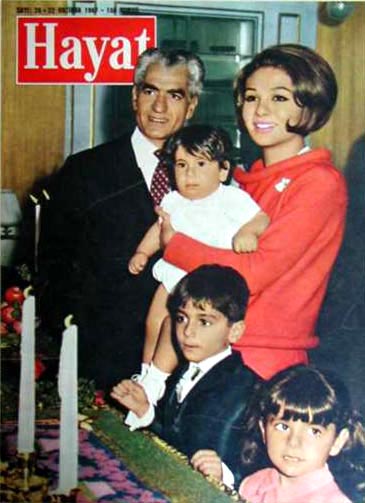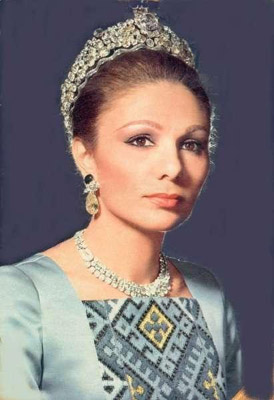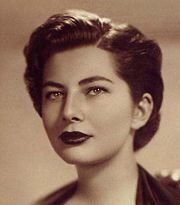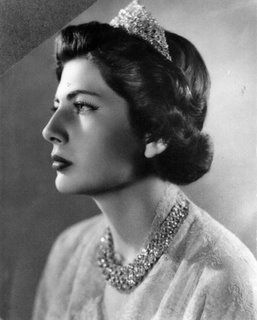The fall of the house of Pahlavi
The sad news of the suicide in Boston of Alireza Pahlavi, the youngest son of the late and last Shah of Iran, is the most recent chapter in the sorrowful saga of the family.
Here they are in happier days. He’s the one being held in his mother’s arms:
His father died in exile of lymphoma at the age of 60, when Alireza was a boy of thirteen. And the little girl in the above photo, younger sister Leila, what of her? Dead at the age of 31 in London of a drug overdose.
The family appears to carry a tendency to depression; Leila had a serious case, and Alireza reportedly also suffered from it after her death. Two other children of the Shah by their mother, former Empress Farah, remain alive, as does Farah herself, who must be overwhelmed with grief.
I hadn’t heard of Farah Pahlavi in decades, but suddenly a distinct memory from my childhood came back—of the Shah’s fiance, movie-star beautiful and featured on the cover of Life, bearing the memorable and euphonious maiden name of Farah Diba. A veritable fairy tale.
But fairy tales always have their dark sides, and I was aware even back then that this one was built on a sad situation.
Did I say Farah looked like a movie star? Indeed:
But Farah’s predecessor Soraya (another lovely name, and another Life favorite, as I recall) also looked like a movie star, and a specific one at that—Ava Gardner. Take a look:
Oh, take two:
Why did the Shah divorce the beauteous Soraya? I remembered that, too, because even as a child I thought it exceptionally sad: she could not have children. And being a shah, he needed a male heir. So Soraya was divorced after she refused to let him take a second simultaneous wife.
Soraya never had children, but she went on to become an actual actress, at least for a little while. She died at 69 under mysterious circumstances in 2001, just a few months after Leila’s death. To compound the sorrow, Soraya’s younger brother died suddenly only a week after her, in a strange foreshadowing of the deaths of Farah’s daughter and son so many years later.
[NOTE: Please see this series of mine about the Iranian Revolution.]





Did I say Farah looked like a movie star? Indeed:
The absence of benevolence and goodwill in her expression strikes me as almost reptilian.
gs: I don’t see it that way at all.
In the top photo, she looks to me like a happy mother. In the one below, much more formal, she looks a tiny bit worried to me. Also, it might have been taken later, when things had gotten worse for the Shah but before they went into exile, which could account for the worried look.
Neo, in the 1970s I shared an office with an Iranian for a year. That might be influencing my attitude.
My reaction is personal as, presumably, is yours. My negative vibe persists, but I don’t claim to have testable evidence.
Persian women are beautiful.
Here’s another beautiful woman murdered for Islam:
http://atlasshrugs2000.typepad.com/atlas_shrugs/2011/01/write-a-letter-for-noor.html
Hi Curtis
Happy new-year to you and other members of neo-neocon tribe!
Re: Persian women are beautiful.
I visited atlasshrugs as you suggested. The two young ladies pictured there-may they both rest in peace-don’t seem to be Persian. Ms. Aqsa Pervez was of Indo/Pakistani heritage.Ms. Noor Almalekil (al-Maleki) though beautiful as you indicated is not likely to be Persian either. Her father’s name, Falah, excludes him from being Persian. Iranian Arab may be, but not Persian.The article “al” preceding the noun “Maleki” indicates it is unlikely that he is, and therefore she was Persian.
It was a two-ruler dynasty, founded by an officer in the barracks. While what succeeded the Pahlavi dynasty was many times worse, I find it difficult to shed tears for the Pahlavi family.
Perhaps the problem with the Shah was that he took American advice, such as the land reform that stirred up the mullahs, as Muslim monasteries et al were big landowners. Etc. In any event, had he not been toppled in early 1979, his death the next year would probably have given the same result, so my comment is academic.
Regarding the eyes of the Shah’s wives, I will not express an opinion, but in the photos of I have seen of the Shah, I see uncertainly in his eyes.
Which reminds me of the Nehru/Gandhi dynasty in India. In his book Who’s in Charge Here?, Gerald Gardner had a photo of Nehru addressing a big crowd. Gardner’s take: “Thank you. And now for my next number.”
A “nothing” commits suicide over “nothing.” The world registers no loss. Yawn! Zzzzzzzzzzzzzz!
Don Janousek: most people who commit suicide are only of interest to their own families. And yet suicides are ordinarily tragic nonetheless.
You and I know nothing about this man and his private demons. I have no idea if they were even related to the historical events that happened to his family. But I would also remind you of this thought.
Alireza might have been better off had he not been highborn. RIP.
My refugee parents were born into successful families though not into high status, but they were positioned for upward mobility. In hindsight I see how bitter it was for them to deal with the shattering of their prospects.
Rose,
I did not mean to suggest the women at the link were Persian, but I appreciate your diligence. I appreciate the truth that all women of all nations are beautiful and mysterious, and the older I get, the more I am angered by the left’s attempt to de-genderize humanity. Something Artfldgr wrote the other day about that–that with the disappearance of the roles and separateness of the sexes we are heading to a genetic result both horrific and final. It makes me believe in the reality of an absolute evil wishing the end of man. I suppose the subject of the lack of play amongst children is another symptom of the same devolution.
But there is no reason to despair as the sacred texts from the great religions assure us that the battle between good and evil is superintended by a loving Creator whose purposes will not be thwarted.
Read a historical novel years ago about pre-Islam Persia. The writer referred to several young folks who were of inhuman beauty due to the aristos’ marrying within their class for a thousand years. Presumably, the less attractive did not marry, or married down and their offspring were read out of society.
For “married”, read “procreated”. Mox nix in this situation.
Claudia Lynx.
neo-neocon: I stand corrected. Thank you for reminding me of the interconnectedness of humanity. One tends to forget such things at times.
Don Janousek: you’re welcome.
I was sad when I read of the suicide of Alireza Pahlavi. Suicides are always sad and tragic.
My feelings are mixed. As an American, I don’t believe in the idea of hereditary nobility. But as a human being, I can understand that a ruling family that has been deposed and exiled must feel like fish out of water.
I feel like they were people I could have known. When I was in college in the late 1970s, I knew a few Iranian students who had come here when the Shah was in power. I don’t know whatever became of them.
And yes, Persian women are among the most beautiful on Earth. I’ve seen them. (sigh)